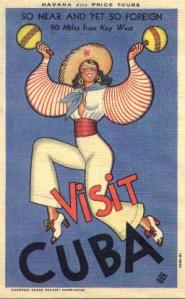
Planet-Love.com: Cyberbrides in the Americas and the Transnational Routes of U.S. Masculinity
by Felicity Schaeffer‐Grabiel
Overview
Schaeffer‐Grabiel’s article examines the online dating phenomenon between U.S. males and Latin American woman. More specifically she seems to be focused on analyzing the benefits American men perceive Latin women have over U.S. women. She begins with the assertion “that this industry does not merely commodify relationships into binaries of the white male buyer and ethnic female seller, as is often repeated in mail-order bride studies (Villipando 1989; Glodava and Onizuka 1994; Tolentino 1999), but involves a more complex and uneven historical moment of racial formation, nationhood, and understandings of masculinity and subjectivity “(332). The author looks to substantiate this by arguing that the love and power aspects of the relationship are intertwined “and inseparable form labor relations, race, gender, and the global economy”(332).
Latin Woman’s Perspective: Schaeffer‐Grabiel notes that the woman’s perspective in not their focus but characterizes their attitudes with: “women perceive U.S. men (as opposed to local men) as more equitable companions in marriage, who value women’s contributions to the home and family and who offer women opportunities to enjoy a stable, middle-class lifestyle”(332). She later on says “Many Latin American women I interviewed were aware that men wanted a woman who was more family oriented than U.S. women supposedly are. In fact, many rejected being labeled a feminist for fear of their association with white women popularly thought to be selfish, sexually loose, or too domineering. This did not mean, however, that women were not strong in their conviction that they wanted a man who respected them and who saw their contributions as carrying equal weight in the family “(341). However the relationships are ultimately best characterized by one latin woman’s quote: “It’s easier for los gringos to masturbate in front of the computer, where they don’t have to put forth any effort to satisfy anyone. Like many things here (in the US), [U.S. men are] . . . the most individualistic and self-absorbed” (interview, December 10, 2004).
U.S. Male’s Perspective: Schaeffer‐Grabiel’s main focus is on the characterization of the process by white males. The white male views it as a “fresh start” and better “shopping experience”. She affirms “many of the men I interviewed repeatedly stated that in Latin America they could date and potentially marry younger and more beautiful women than in the United States “(333). “They hope for a fresh start in Latin America through their search for better wives and mothers while constructing a heightened moral and class status within the global world order as the “good guys,” heroes, or sensitive “new men” crafted against the macho Latin male stereotype “(333). Not only do men view their marriage to a Latin as a fresh start culturally, but Schaffer-Gabriel highlights the fresh genetic aspect of the Latin woman. Many company Web sites and men idealize Latin American women as having better genes than U.S. women or, as Jason described, better “raw materials” (interview, March 2005). Though ultimately she highlights the demise of these relationships as she notes “while men may enjoy a boost in status in Latin America, they may find this wears off once they return home”(351-52).
No, Schaeffer‐Grabiel thinks it’s much deeper–
“Thus, finding a foreign bride converges with four discourses: colonialism, modern self-help movements, transnational capitalism, and futuristic ideals of flexibility, mobility, and a postracial society. These themes demonstrate the ways technology and ideas about globalization are incorporated into men’s everyday lives as a yearning for a utopian, multiracial, postbody affinity to masculinity and citizenship, regardless of skin color, profession, or class affiliation”(334).
Schaeffer‐Grabiel builds on the theories that “European and Western dominance shaped the formation of a white male national citizenship through the extraction of labor and sexuality from native others”(336). She states, “I depart from this linear narrative of colonization to globalization by arguing that this new transnational masculinity builds on previous colonialist fantasies and rewrites them by drawing from the discourse of corporate multiculturalism. In other words, masculinity is not associated with colonial constructions of Western whiteness in contrast to racialized, native “others” or with contemporary anti-immigration nativism and white supremacy. Instead, men imagine themselves as the benevolent engineers who racially uplift the moral fabric of the national family by importing a superior breed of women”(337).
Her claim is the white male’s “nationalism is founded on the preservation of an invented traditional past and a future vision of modernity”(338). “Men access a multicultural patriotic manhood through adherence to the ideal American values at the foundation of the immigrant’s assimilation into the nation: hard work, traditional family values and gender roles, and notions of benevolence couched in romantic ethics of chivalry and the saving of women”(338). The idea is the white male believes these are all modern cultural ideologies, and in adhering to these in helping the Latin woman, he substantiates his masculinity. He considers himself a modern man.
Final Frontier-
Schaeffer‐Grabiel believes Cornell and Hooper miss-step in saying the U.S. male’s masculinity and dominance is a product of being a “business entrepreneur” in a “global marketplace”. She has a different view regarding the nature of the white males masculinity. She first asserts that many of the men expressed feelings of being “alienated in some way from U.S. culture and society”. She goes on, “he realized he was replaceable in both his professional and intimate life”(338). The white male claims to be a victim of the feminist movement: his modern wife lacks culture and tradition, with a job she is not dependent on him and therefore he is not necessarily dominate. He highjacks the feminist movement, “men imagine Latin American women as the last pure frontier, bodies that promise to rectify a crisis in U.S. masculinity and the breakdown of middle-class family structures. They moralize the need for new genes and bodies and for a postnational family structure that will rejuvenate not only the U.S. domestic sphere but also their own inner journeys to selfhood”(339). In other words, these men feel emasculated by the feminist model, and seek the “less liberated woman (340)” Male participants claim to want someone who is less spoiled and materialistic.
“Latin American and other “foreign” women are naturalized as having the right biological makeup and cultural grooming, making them more feminine, traditional, docile, and better mothers of the family. Unlike nineteenth-century constructions of racial mixing as degenerative, in this instance foreign genes are constructed as regenerative. This shift in racial construction connects with individualistic ideals of multiculturalism in the global marketplace. Once again, diversity and race are advertised as products that promise to bring one closer to nature, toward one’s “true self,” and to contribute to the making of “natural” gender and racial hierarchies.”(341).
What I think Schaeffer‐Grabiel is saying is that men seek to obtain their dominant, masculine-self, or “true-self”, in marrying a Latin woman whose culture he believes is conducive to gender and racial hierarchies. At the same time this evokes feelings of nationalism as the the white male feels he is a “genetic engineer”, bringing in “raw materials” that are less tainted but the U.S. culture, or more specifically, the feminist movement.
Wendy Kline has no sympathy for the emasculated man. She argues David Popenoe sounds just like his father Paul Popenoe who lamented about the decaying of racial hierarchy, the difference is David laments about the decaying of social hierarchy through the feminists movement (342).
Self-help-
“The self-help model of individual transformation hijacks the feminist model of consciousness-raising, evacuating its radical potential through personalizing social transformation, and makes evident self-help’s genealogical roots within Christianity and Western individualism”(352).
“Many men’s groups convey feeling disempowered by feminism and advocate empowerment, coming to self-actualization through the collective sharing of oneself”(347). She goes on, “Divorced from the original goals of consciousness-raising—which were to critique how social structures affect the individual, to make the privileges of race and class visible, and to connect the personal worlds of women with larger structures of power—men focus on the individual and ignore rather than reveal these privileges”(347-48). I think Schaeffer‐Grabiel’s main point is that men claim to be the victim of feminism and complain of how they are affected individually, rather than highlight how gender hierarchy negatively affects woman collectively. The fact is gender and class hierarchy is the very driver in his ability to “bride shop” online. He fails to recognize how the feminist movement has contributed to the creation of the self-help ecosystem he enjoys, and later how his Latin wife will react when she assimilates with the feminist model.
She goes on “men blame consumption, materialism, and even greed for high divorce rates, for the fact that women leave them for wealthier and younger men, or that women seek their own empowerment through entering the work- force”(352). “Through their desire to improve the culture of national family, they are caught in the dilemma of embracing ethnic, gender, religious, and national differences while maintaining global hierarchies”(352). She argues that inevitably the relationships that are structured on heightening the U.S. males sense of masculinity, fail when the woman assimilates into American society.
Schaeffer‐Grabiel concludes “while many men turn to Latin American women and culture in hopes of living a life outside of the tyranny of capitalism, materialism, and rugged individualism, many simply seek a fantasy-ridden image of women as the object of change they seek to import back home without having to change anything about themselves”(353).
Her point is men seek a relationship that maintain their gendered hierarchy when in reality this is the very aspect of the relationship that is hardest to preserve in along side the feminist model. The male claims his dilemma arrises when the Latin wife assumes his social class when they marry and later develops her own sense of self through the modern feminist model. In blaming feminism he seeks to directly target it. Rather than address the person change he may have to make to make his relationship work, the white male instead looks to handicap the woman’s ability to be independent from him. Specifically, he seeks a woman that he has ultimate class and gender hierarchy over. – crazy
Questions:
Are U.S. males wrong in assuming Latin woman are culturally more submissive? Or is this simply an assertion that changes as Latin women experience the greater equality of rights they are afforded America?
In what ways is this dating culture reflective of the greater social views held by the American adult male? How does this play into American policies on immigration?










You must be logged in to post a comment.